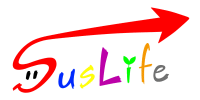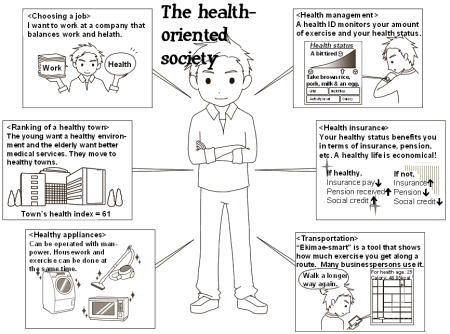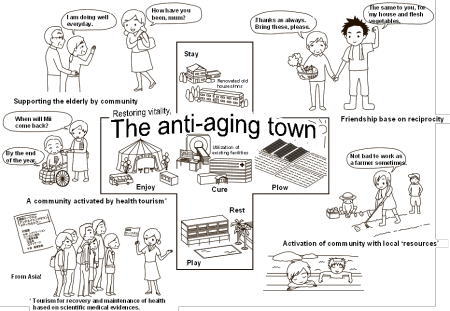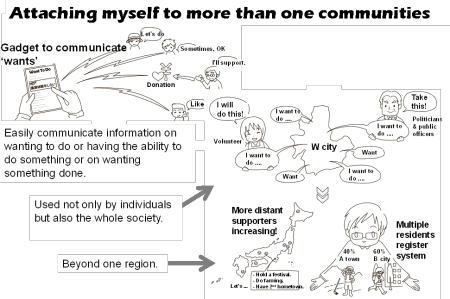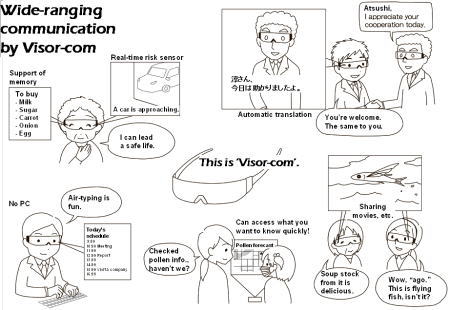We used constrained idea generation (impact dynamics) to combine the future issues with the future-signs for new trends (Hypotheses on social changes). We summarized the results to some extent and created stories. After the workshop, participants from NIES and Hakuhodo discussed and analyzed the ideas in detail. Taking the views of experts into account, we revised and modified the stories to produce the four scenarios described below. These scenarios are neither predictions of how the future will be nor goals to be aimed at. They are "possible futures", objectively portrayed using the technique of future insight.
1. Health-Oriented Society
Currently, the birth rate in Japan is falling and the population is getting older. There is concern that social support systems such as medical care and pensions will become dysfunctional. Given these trends in society, being healthy will have a new status in 2030. A record called a health scorecard, in which the state of a person's mental and physical health and their levels of physical activity are quantified, will be used in many different ways every day and will make it easier for individuals to manage their own health. Tools will be developed such as "Smart Station" that promote walking during travel to work and digital electronics that improve health if used every day; people will be able to manage their health more enjoyably and effectively. Companies will promote a good "work–health balance", as it will be called in the future, and local governments will compete to raise the health scores of their citizens. People will know which areas and workplaces have better health scores and will want to move to them. Changes in society will emerge, such as businesses that care for the health of their workers having better results. The motivations for these changes will include lower health insurance premiums and higher prospective pensions for those who are healthy, both individuals and areas.
2. Anti-Aging Town -Restoring Vitality
In 2030, communities known as "anti-aging towns" will be created in the suburbs of the cities with the goal of caring for mind and body and preserving health. Medical institutions and health-focused amusement parks will be sited in the middle of these towns, close by accommodation facilities and the like. Services for providing moderate exercise and a change of pace and services for beauty treatments will be 'provided' for all ages. People needing recuperation or care will move to live there and workers from the cities will visit to restore tired spirits and bodies. Japan will be known throughout the world for its breadth of health data; increasing numbers of people will visit from abroad to experience this. The anti-aging towns will provide assistance for various activities. Local vegetables will be available and other goods can be bought at low prices. These and other advantages will make it possible to live more cheaply and achieve greater happiness, which will make the towns desirable. Young people who do not find jobs in the cities will find workplaces and homes in the anti-aging towns, bringing more life to them. Anti-aging towns will also be attractive in offering lifestyles that have higher self-sufficiency for local food and energy.
3. Attaching myself to more than one community
In 2030, software and social organizations for people to communicate what they want to do will have been developed and will be used by many people. Individuals will be able to easily exchange information about their hopes for their future—what they want to do/be able to do and what they want other people to do—and achieve things together. Even for something that a person only wants to do occasionally, it will be easy to join a group of people who want to do the same thing; it will be easy for anyone to find and contribute to activities that they find meaningful. People who have not had any previous connections will link up and a range of activities will become more common. It will be possible to get information about what people in an area want to do, there will be more volunteer activities meeting the area's needs, and politicians and administrators will make use of this information. People will be making more connections beyond their local area and community-building activities will have more supporters from outside the area. People will even be able to register as residents in multiple areas: There will be more people enjoying a lifestyle with two bases and people finding a home away from home. In this society, those who have the knowledge and skills to enable people to do what they want will be in demand.
4. Wide-ranging Communication by Visor-com
In 2030, we will have a society in which people make use of the Visor-com—an enhanced communication tool that resembles a pair of glasses—at home, in the workplace, anywhere. Automatic interpreting technologies that can break through the language barrier with foreigners are installed in the Visor-com; communication with foreigners will no longer feel like a struggle. The Visor-com will be able to easily access information such as videos and sound recordings, which can be shared with conversation partners, broadening the scope of conversations. It will also be easy to consult a dictionary or check the news. The Visor-com will remember a shopping list so that the wearer does not forget anything. The Visor-com will be able to tell the wearer information about their location in real time; for example, it will give them a warning when a car is coming up the road. The Visor-com can be controlled by voice or by eye movements, but text can also be inputted by keyboard as in a present-day computer. Even without an actual keyboard, the Visor-com can detect finger movements and interpret them as key-presses.
